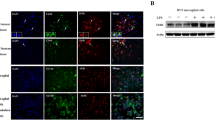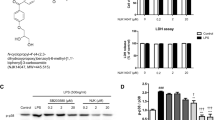Abstract
Neuroinflammation is critical in the pathogenesis of neurological diseases. Microglial pro-inflammatory (M1) and anti-inflammatory (M2) status determines the outcome of neuroinflammation. Dexmedetomidine exerts anti-inflammatory effects in many neurological conditions. Whether dexmedetomidine functions via modulation of microglia M1/M2 polarization remains to be fully elucidated. In the present study, we investigated the anti-inflammatory effects of dexmedetomidine on the neuroinflammatory cell model and explored the potential mechanism. BV2 cells were stimulated with LPS to establish a neuroinflammatory model. The cell viability was determined with MTT assay. NO levels were assessed using a NO detection kit. The protein levels of IL-10, TNF-α, iNOS, CD206, ERK1/2, and pERK1/2 were quantified using Western blotting. LPS significantly increased pro-inflammatory factors TNF-α and NO, and M1 phenotypic marker iNOS, and decreased anti-inflammatory factor IL-10 and M2 phenotypic marker CD206 in BV2 cells. Furthermore, exposure of BV2 cells to LPS significantly raised pERK1/2 expression. Pretreatment with dexmedetomidine attenuated LPS-elicited changes in p-ERK, iNOS, TNF-α, NO, CD206 and IL-10 levels in BV2 cells. However, co-treatment with dexmedetomidine and LM22B-10, an agonist of ERK, reversed dexmedetomidine-elicited changes in p-ERK, iNOS, TNF-α, NO, CD206 and IL-10 levels in LPS-exposed BV2 cells. We, for the first time, showed that dexmedetomidine increases microglial M2 polarization by inhibiting phosphorylation of ERK1/2, by which it exerts anti-inflammatory effects in BV2 cells.




Similar content being viewed by others
Abbreviations
- CNS:
-
Central nervous system
- AD:
-
Alzheimer’s disease
- PD:
-
Parkinson’s disease
- ALS:
-
Amyotrophic lateral sclerosis
- TBI:
-
Traumatic brain injury
- POCD:
-
Postoperative cognitive dysfunction
- POD:
-
Postoperative delirium
- MAPKs:
-
Mitogen-activated protein kinases
- ERK1/2:
-
Extracellular signal-regulated protein kinase 1/2
- NO:
-
Nitric oxide
- Dex:
-
Dexmedetomidine
Reference
Hanisch UK, Kettenmann H (2007) Microglia: active sensor and versatile effector cells in the normal and pathologic brain. Nat Neurosci 10(11):1387–1394. https://doi.org/10.1038/nn1997
Volpe CM, Nogueira-Machado JA (2015) Is innate immunity and inflammasomes involved in pathogenesis of amyotrophic lateral sclerosis (ALS)? Recent Pat Endocr Metab Immune Drug Discov 9(1):40–45
Liu L, Chan C (2014) The role of inflammasome in Alzheimer's disease. Ageing Res Rev 15:6–15. https://doi.org/10.1016/j.arr.2013.12.007
Gelders G, Baekelandt V, Van der Perren A (2018) Linking neuroinflammation and neurodegeneration in Parkinson's disease. J Immunol Res 2018:4784268. https://doi.org/10.1155/2018/4784268
Lenzlinger PM, Kossmann. MCM, Laurer HL (2001) The duality of the inflammatory response to traumatic brain injury. Mol Neurobiol 24(1–3):169–181
Lee GA, Lin TN, Chen CY, Mau SY, Huang WZ, Kao YC, Ma RY, Liao NS (2018) Interleukin 15 blockade protects the brain from cerebral ischemia-reperfusion injury. Brain Behav Immun 73:562–570. https://doi.org/10.1016/j.bbi.2018.06.021
Dantzer R, O’Connor JC, Freund GG, Johnson RW, Kelley KW (2008) From inflammation to sickness and depression: when the immune system subjugates the brain. Nat Rev Neurosci 9(1):46–56. https://doi.org/10.1038/nrn2297
Barrientos RM, Hein AM, Frank MG, Watkins LR, Maier SF (2012) Intracisternal interleukin-1 receptor antagonist prevents postoperative cognitive decline and neuroinflammatory response in aged rats. J Neurosci 32(42):14641–14648. https://doi.org/10.1523/jneurosci.2173-12.2012
Su X, Meng ZT, Wu XH, Cui F, Li HL, Wang DX, Zhu X, Zhu SN, Maze M, Ma D (2016) Dexmedetomidine for prevention of delirium in elderly patients after non-cardiac surgery: a randomised, double-blind, placebo-controlled trial. Lancet 388(10054):1893–1902. https://doi.org/10.1016/s0140-6736(16)30580-3
Tan F, Gan X, Deng Y, Li X, Guo N, Hei Z, Zhu Q, Chen ZG, Zhou S (2018) Intraoperative dexmedetomidine attenuates postoperative systemic inflammatory response syndrome in patients who underwent percutaneous nephrolithotomy: a retrospective cohort study. Ther Clin Risk Manag 14:287–293. https://doi.org/10.2147/TCRM.S157320
Chen C, Qian Y (2016) Protective role of dexmedetomidine in unmethylated CpG-induced inflammation responses in BV2 microglia cells. Folia Neuropathol 54(4):382–391. https://doi.org/10.5114/fn.2016.64817
Liu W, Yu W, Weng Y, Wang Y, Sheng M (2017) Dexmedetomidine ameliorates the inflammatory immune response in rats with acute kidney damage. Exp Ther Med 14(4):3602–3608. https://doi.org/10.3892/etm.2017.4954
Zhang X, Yan F, Feng J, Qian H, Cheng Z, Yang Q, Wu Y, Zhao Z, Li A, Xiao H (2018) Dexmedetomidine inhibits inflammatory reaction in the hippocampus of septic rats by suppressing NF-kappaB pathway. PLoS ONE 13(5):e0196897. https://doi.org/10.1371/journal.pone.0196897
Qiu R, Yao W, Ji H, Yuan D, Gao X, Sha W, Wang F, Huang P, Hei Z (2018) Dexmedetomidine restores septic renal function via promoting inflammation resolution in a rat sepsis model. Life Sci 204:1–8. https://doi.org/10.1016/j.lfs.2018.05.001
Chen Z, Zhang X, Liu Y, Liu Z (2016) Morphine postconditioning protects against reperfusion injury via inhibiting JNK/p38 MAPK and mitochondrial permeability transition pores signaling pathways. Cell Physiol Biochem 39(1):61–70. https://doi.org/10.1159/000445605
Odaka H, Numakawa T, Yoshimura A, Nakajima S, Adachi N, Ooshima Y, Inoue T, Kunugi H (2016) Chronic glucocorticoid exposure suppressed the differentiation and survival of embryonic neural stem/progenitor cells: possible involvement of ERK and PI3K/Akt signaling in the neuronal differentiation. Neurosci Res 113:28–36. https://doi.org/10.1016/j.neures.2016.07.002
JS JP, UB MBK, JW C, MS Y, IK C K (2015) Mitochondrial ROS govern the LPS-induced pro-inflammatory response in microglia cells by regulating MAPK and NF-κB pathways. Neurosci Lett 584:191–196
Kim AR, Lee B, Joung E-J, Gwon W-G, Utsuki T, Kim N-G, Kim H-R (2016) 6,6′-Bieckol suppresses inflammatory responses by down-regulating nuclear factor-κB activation via Akt, JNK, and p38 MAPK in LPS-stimulated microglial cells. Immunopharmacol Immunotoxicol 38(3):244–252. https://doi.org/10.3109/08923973.2016.1173060
Xu S, Zhu W, Shao M, Zhang F, Guo J, Xu H, Jiang J, Ma X, Xia X, Zhi X, Zhou P, Lu F (2018) Ecto-5′-nucleotidase (CD73) attenuates inflammation after spinal cord injury by promoting macrophages/microglia M2 polarization in mice. J Neuroinflamm 15(1):155. https://doi.org/10.1186/s12974-018-1183-8
Schoeler M, Loetscher PD, Rossaint R, Fahlenkamp AV, Eberhardt G, Rex S, Weis J, Coburn M (2012) Dexmedetomidine is neuroprotective in an in vitro model for traumatic brain injury. BMC Neurol 12(1):20. https://doi.org/10.1186/1471-2377-12-20
Su X, Chen Q, Chen W, Chen T, Li W, Li Y, Dou X, Zhang Y, Shen Y, Wu H, Yu C (2014) Mycoepoxydiene inhibits activation of BV2 microglia stimulated by lipopolysaccharide through suppressing NF-kappaB, ERK1/2 and toll-like receptor pathways. Int Immunopharmacol 19(1):88–93. https://doi.org/10.1016/j.intimp.2014.01.004
Wu ZT, Ren CZ, Yang YH, Zhang RW, Sun JC, Wang YK, Su DF, Wang WZ (2016) The PI3K signaling-mediated nitric oxide contributes to cardiovascular effects of angiotensin-(1–7) in the nucleus tractus solitarii of rats. Nitric Oxide Biol Chem 52:56–65. https://doi.org/10.1016/j.niox.2015.12.002
Tam WY, Ma CH (2014) Bipolar/rod-shaped microglia are proliferating microglia with distinct M1/M2 phenotypes. Sci Rep 4:7279. https://doi.org/10.1038/srep07279
Hu X, Li P, Guo Y, Wang H, Leak RK, Chen S, Gao Y, Chen J (2012) Microglia/macrophage polarization dynamics reveal novel mechanism of injury expansion after focal cerebral ischemia. Stroke 43(11):3063–3070. https://doi.org/10.1161/STROKEAHA.112.659656
Peng M, Wang YL, Wang CY, Chen C (2013) Dexmedetomidine attenuates lipopolysaccharide-induced proinflammatory response in primary microglia. J Surg Res 179(1):e219–e225. https://doi.org/10.1016/j.jss.2012.05.047
Rodriguez-Gonzalez R, Sobrino T, Veiga S, Lopez P, Rodriguez-Garcia J, del Rio SV, Baluja A, Castillo J, Alvarez J (2016) Neuroprotective effects of dexmedetomIDine conditioning strategies: evidences from an in vitro model of cerebral ischemia. Life Sci 144:162–169. https://doi.org/10.1016/j.lfs.2015.12.007
Lu P, Lei S, Li W, Lu Y, Zheng J, Wang N, Xia Y, Lu H, Chen X, Liu Y, Zhang PB (2018) Dexmedetomidine protects neural stem cells from Ketamine-induced injury. Cell Physiol Biochem 47(4):1377–1388. https://doi.org/10.1159/000490823
Sun Z, Lin Y, Li Y, Ren T, Du G, Wang J, Jin X, Yang LC (2018) The effect of dexmedetomidine on inflammatory inhibition and microglial polarization in BV-2 cells. Neurol Res 40(10):838–846. https://doi.org/10.1080/01616412.2018.1493849
Zhao XP, Zhao Y, Qin XY, Wan LY, Fan XX (2019) Non-invasive vagus nerve stimulation protects against cerebral ischemia/reperfusion injury and promotes Microglial M2 polarization via interleukin-17A inhibition. J Mol Neurosci 67(2):217–226. https://doi.org/10.1007/s12031-018-1227-7
Zhou S, Zhu W, Zhang Y, Pan S, Bao J (2018) S100B promotes microglia M1 polarization and migration to aggravate cerebral ischemia. Inflamm Res 67(11–12):937–949. https://doi.org/10.1007/s00011-018-1187-y
Gaire BP, Song MR, Choi JW (2018) Sphingosine 1-phosphate receptor subtype 3 (S1P3) contributes to brain injury after transient focal cerebral ischemia via modulating microglial activation and their M1 polarization. J Neuroinflamm 15(1):284. https://doi.org/10.1186/s12974-018-1323-1
Hu H, Li Z, Zhu X, Lin R, Chen L (2014) Salidroside reduces cell mobility via NF- kappa B and MAPK signaling in LPS-induced BV2 microglial cells. Evid Based Complement Altern Med 2014:383821. https://doi.org/10.1155/2014/383821
Hu SP, Zhao JJ, Wang WX, Liu Y, Wu HF, Chen C, Yu L, Gui JB (2017) Dexmedetomidine increases acetylation level of histone through ERK1/2 pathway in dopamine neuron. Hum Exp Toxicol 36(5):474–482. https://doi.org/10.1177/0960327116652458
Wang Y, Han R, Zuo Z (2016) Dexmedetomidine post-treatment induces neuroprotection via activation of extracellular signal-regulated kinase in rats with subarachnoid haemorrhage. Br J Anaesth 116(3):384–392. https://doi.org/10.1093/bja/aev549
Liao Z, Cao D, Han X, Liu C, Peng J, Zuo Z, Wang F, Li Y (2014) Both JNK and P38 MAPK pathways participate in the protection by dexmedetomidine against isoflurane-induced neuroapoptosis in the hippocampus of neonatal rats. Brain Res Bull 107:69–78. https://doi.org/10.1016/j.brainresbull.2014.07.001
Zhai MZ, Wu HH, Yin JB, Cui YY, Mei XP, Zhang H, Zhu X, Shen XF, Kaye AD, Chen GZ (2016) Dexmedetomidine dose-dependently attenuates ropivacaine-induced seizures and negative emotions via inhibiting phosphorylation of amygdala extracellular signal-regulated kinase in mice. Mol Neurobiol 53(4):2636–2646. https://doi.org/10.1007/s12035-015-9276-1
Zhang J, Wang Z, Wang Y, Zhou G, Li H (2015) The effect of dexmedetomidine on inflammatory response of septic rats. BMC Anesthesiol 15:68. https://doi.org/10.1186/s12871-015-0042-8
Lin JP, Chen CQ, Huang LE, Li NN, Yang Y, Zhu SM, Yao YX (2018) DexmedetomIdine attenuates neuropathic pain by inhibiting P2 × 7R expression and ERK phosphorylation in rats. Exp Neurobiol 27(4):267–276. https://doi.org/10.5607/en.2018.27.4.267
Liu Y, Liu W, Wang X, Wan Z, Liu Y, Leng Y (2018) Dexmedetomidine relieves acute inflammatory visceral pain in rats through the ERK pathway, toll-like receptor signaling, and TRPV1 channel. J Mol Neurosci 66(2):279–290. https://doi.org/10.1007/s12031-018-1172-5
Schoeler M, Loetscher PD, Rossaint R, Fahlenkamp AV, Eberhardt G, Rex S, Weis J, Coburn M (2012) Dexmedetomidine is neuroprotective in an in vitro model for traumatic brain injury. BMC Neurol 12:20. https://doi.org/10.1186/1471-2377-12-20
Wang K, Zhu Y (2018) Dexmedetomidine protects against oxygen-glucose deprivation/reoxygenation injury-induced apoptosis via the p38 MAPK/ERK signalling pathway. J Int Med Res 46(2):675–686. https://doi.org/10.1177/0300060517734460
Zhang X, Wang J, Qian W, Zhao J, Sun L, Qian Y, Xiao H (2015) Dexmedetomidine inhibits inducible nitric oxide synthase in lipopolysaccharide-stimulated microglia by suppression of extracellular signal-regulated kinase. Neurol Res 37(3):238–245. https://doi.org/10.1179/1743132814y.0000000426
Cussac D, Schaak S, Gales C, Flordellis C, Denis C, Paris H (2002) alpha(2B)-Adrenergic receptors activate MAPK and modulate proliferation of primary cultured proximal tubule cells. Am J Physiol Renal Physiol 282(5):F943–F952. https://doi.org/10.1152/ajprenal.0108.2001
Du T, Li B, Liu S, Zang P, Prevot V, Hertz L, Peng L (2009) ERK phosphorylation in intact, adult brain by alpha(2)-adrenergic transactivation of EGF receptors. Neurochem Int 55(7):593–600. https://doi.org/10.1016/j.neuint.2009.05.016
Castillo LF, Rivero EM, Goffin V, Luthy IA (2017) Alpha2-adrenoceptor agonists trigger prolactin signaling in breast cancer cells. Cell Signal 34:76–85. https://doi.org/10.1016/j.cellsig.2017.03.003
Acknowledgements
This work was supported by the National Natural Science Foundation of China (81071071, 81171247), Key Science and Technology Innovation Team of Shaanxi Province (2014KCT-22) and Science and Technology Development Project of Shaanxi Province Grants (2013KTCL03-09). We would also like to thank Prof. Malgorzata Garstka for langue correction.
Author information
Authors and Affiliations
Corresponding author
Ethics declarations
Conflict of interest
The authors declare that there are no conflicts of interest associated with this study.
Additional information
Publisher's Note
Springer Nature remains neutral with regard to jurisdictional claims in published maps and institutional affiliations.
Rights and permissions
About this article
Cite this article
Qiu, Z., Lu, P., Wang, K. et al. Dexmedetomidine Inhibits Neuroinflammation by Altering Microglial M1/M2 Polarization Through MAPK/ERK Pathway. Neurochem Res 45, 345–353 (2020). https://doi.org/10.1007/s11064-019-02922-1
Received:
Revised:
Accepted:
Published:
Issue Date:
DOI: https://doi.org/10.1007/s11064-019-02922-1




